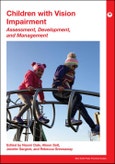Vision impairment is a long-term condition caused by disorders of the eye, optic nerve, and brain. Using evidence-based knowledge, theory, and research, this book provides practical guidance for practitioners who are involved in the care and management of children with long-term vision impairment and disability. The book is divided into four sections following the ICF-CY model: (1) eye disorders, vision and brain, (2) child development and learning from birth to older childhood, (3) habilitation, orientation, reading and assistive technologies and (4) social relationships and participation in everyday contexts.
- International team of experts present up to date vision and neuroscience research and assessment and management approaches.
- Multidisciplinary approaches for improving function, learning and activity in children with vision impairment.
- New approach to childhood vision impairment with a focus on assessment, function and participation.
- Covering all vision disorders and levels of vision impairment, including eye disorders, cerebral vision impairment and complex disability.
A useful resource for developmental/and neurodisability paediatricians and clinicians including clinical, neuro- and educational psychologists, occupational therapists, speech and language therapists, physiotherapists; paediatric ophthalmologists and eye clinic staff; mobility/habilitation specialists, educationalists of vision impairment and others; community family support and social care workers.
Table of Contents
Author Appointments
Foreword
Preface
1 Introduction
Naomi Dale, Alison Salt, Jenefer Sargent, and Rebecca Greenaway
PART 1 Eye disorders, vision and brain
2 Childhood vision functions, classification and causes of childhood visual impairment
Ameenat Lola, Solebo, Jugnoo, and Sangeeta Rahi
3 Congenital eye disorders: genetics and clinical phenotypes
Mariya Moosajee and Ngozi Oluonye
4 Assessment and habilitation of vision in infants and young children
Alison Salt and Jenefer Sargent
5 Cerebral visual impairment
Naomi Dale, Els Ortibus, Jenefer Sargent, and Richard Bowman
6 Vision assessment of children with complex neurodisability
Jenefer Sargent, Alison Salt, and Elisa Fazzi
7 Brain development and plasticity
Francesca Tinelli and Andrea Guzzetta
PART 2 Child development and learning from birth to older childhood
8 Early years, early intervention and family support
Naomi Dale, Elena Sakkalou, and Jackie Osborne
9 Motor development and hand function
Julia Smyth and Alison Salt
10 Language and communication development
Steve Rose, Kim Bates, and Rebecca Greenaway
11 Social communication and autism spectrum disorder
Naomi Dale and Alison Salt
12 Cognition
Rebecca Greenaway and Simon Ungar
13 Experience of parenting a child with vision impairment
Christopher Clark and Kate Clark
PART 3 Further approaches to habilitation
14 Orientation, Mobility and Independence Skills: Habilitation Approaches
Jessica Hayton and Susan Mort
15 Technological aids for spatial perception and mobility
Monica Gori and Giulia Cappagli
16 Low vision aids and assistive technologies for reading, learning and education
Michael Crossland, Annegret Dahlmann-Noor, and Ngozi Oluonye
17 Reading Approaches for Braille Readers
M Cay Holbrook and Kim T Zebehazy
PART 4 Social relationships and participation
18 Psychological wellbeing, mental health and behaviour
Clare Jackson
19 Self-concept and social relationships for quality of life and participation
Mathijis Vervloed and Sabina Kef
20 Towards autonomy and independence in adolescence
Graeme Douglas, Mike McLinden, and Rachel Hewett
21 Personal experiences from a young person
Holly Tuke
Index








